Purple flowers are more attractive. Here is information about purple flowers of different plants. A judicious use of colors is essential to make the garden attractive and stylish, with purple flowers being the most popular. The color purple is considered a symbol of royalty. A plant with purple flowers and green leaves adds to the beauty of the garden. These types of plants mostly bloom in spring.
[1] Clematis ‘Jackmanii’

Clematis ‘Jackman’ is a flowering vine. This plant bears purple colored flowers, which are beautiful in appearance. This plant is still found in gardens. The plant was developed from crosses made 1837-1887 by George Jackman, a leading nurseryman of Woking, Jackman & Sons, Surrey. Clematis has 5-inch delicious purple blooms. The vines of this clematis can be used to make any shape we like, and are also useful for making fences. This plant is famous for wall decoration. Clematis are planted in late summer or spring.
Clematis Plant Overview
- Botanical Name: Clematis ‘Jackmanii’
- Common Name: Jackman virgin’s bower, Jackman’s clematis, Jackman clematis
- Family: Ranunculaceae
- Plant Type: Vine
- Bloom Time: Summer
- Soil Type: Moist but well-drained
- Soil pH: Neutral
- Sun Exposure: Partial, full
- Mature Size: 7-15 ft. long
- Plant Flowers Color: Blue, purple
- Hardiness Zones: 4-8 (USDA)
- Native Area: Cultivar, no native range
How to Grow & Care
This plant is a perennial creeper that you can plant to beautify the garden. This plant likes partial shade. Plant it in a northerly direction during summer. Clematis prefers well-drained and fertile soil where its flowers bloom well. It is important to keep the soil relatively cool while growing it. Water regularly for this plant, the topsoil should never dry out, and it likes constant moisture.
This plant has been brought from a nursery. Now dig a deep and wide hole in the ground and add the required fertilizer to grow this plant. This plant likes warm air but cannot tolerate summer heat. Clematis should be kept slightly moist, and fertilize the soil as needed.
[2] Petunia
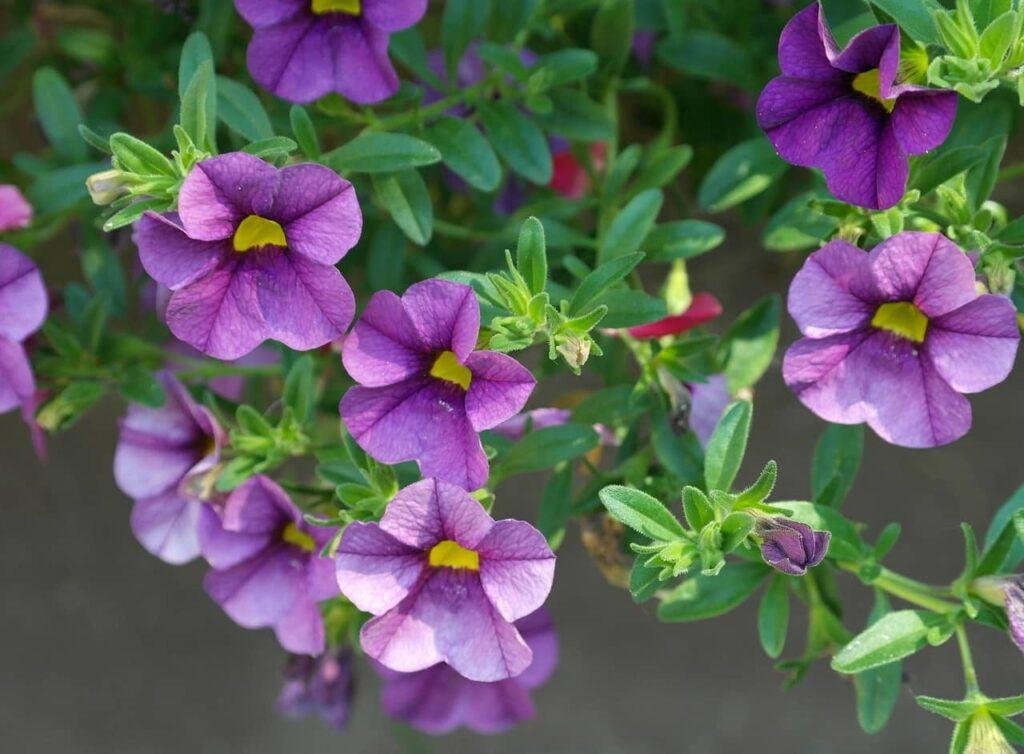
Petunia plants have purple flowers that are native to South America. The name of the flower of this plant is derived from the French word meaning petunia ‘tobacco’ from the Tupi-Guarani language. Garden species of this plant are hybrids such as Petunia akinesia known as hybrids. The flower of this plant is one of the most popular flowers in the garden, and its flowers come in many colors, but blue and purple flowers look best. These flowers are trumpet-shaped. Petunias are fast-growing plants that reach full size by late spring.
Petunia Plant Overview
- Botanical Name: Petunia spp.
- Common Name: Petunia
- Family: Solanaceae
- Plant Type: Annual, perennial
- Bloom Time: Spring, summer, fall
- Soil Type: Well-drained, moist
- Soil pH: Acidic
- Sun Exposure: Full
- Mature Size: 6–24 in. tall, 6-36 in. wide
- Plant Flowers Color: Pink, purple, yellow, red, orange, green, white
- Hardiness Zones: 10–11 (USDA)
- Native Area: South America
How to Grow & Care
Petunia plants are elementary to care for. These plants require a lot of light, so about six hours of direct sunlight a day is necessary. For the plant to grow well, it needs to be watered and fed regularly from spring to autumn. This plant prefers slightly acidic, light and fertile soil, and may be at risk during frosts. These plants do not like to be dry, and too much moisture will rot their roots. They want moderate humidity. Petunias need temperatures around 60 degrees to 75 degrees Fahrenheit and 55 degrees to 65 degrees Fahrenheit at night. Cold temperatures damage it. Fertilize this plant while growing. So that the plant grows fast and the flowers get good color.
[3] Anemone
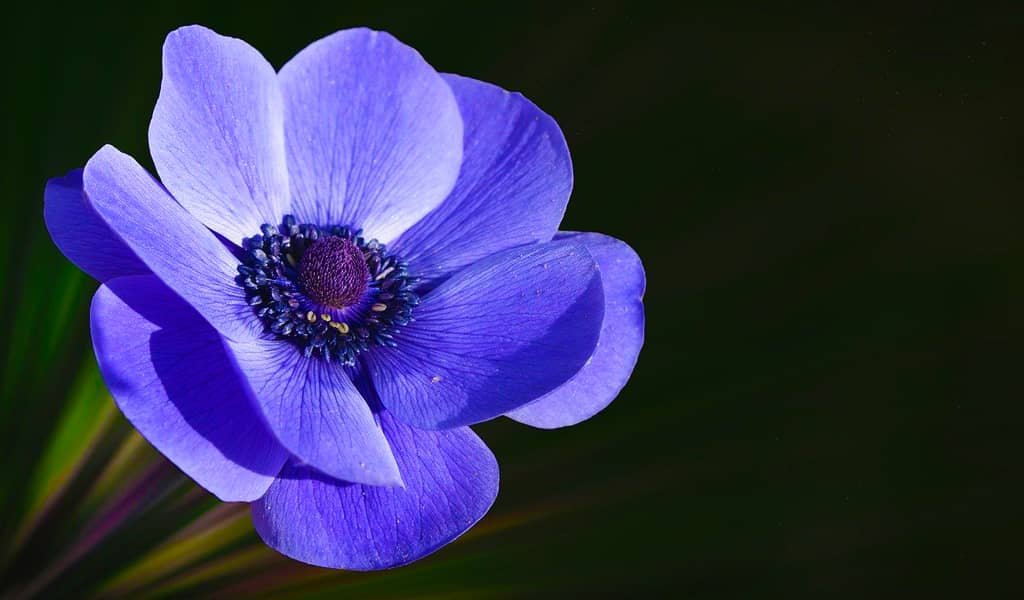
Anemone is a genus of flowers in the buttercup family. Plants of this genus are commonly known as windflowers because the flowers of this plant sway with the wind. Anemones are not found in Antarctica, New Zealand, and Australia but are found in other continents. Animos means “wind” in Greek. The leaves are at the base of the plant, while the flower is two to five inches in diameter on a long stem. The colors of these flowers also depend on different species, and the color also varies depending on the species.
Anemone Plant Overview
- Botanical Name: Anemone spp.
- Common Name: Grecian windflower, anemone, windflower, poppy windflower
- Family: Ranunculaceae
- Plant Type: Herbaceous perennial
- Bloom Time: Spring, summer
- Soil Type: Rich, moist
- Soil pH: Acidic, neutral
- Sun Exposure: Full to partial sun
- Mature Size: 6 in. – 4 ft. tall, 2–3 ft. wide (varies by species)
- Plant Flowers Color: Red, orange, yellow-green, blue, purple, red-purple, white, ivory, pink
- Hardiness Zones: 3–10 (USDA); varies by species
- Native Area: North America
How to Grow & Care
Planting time for anemone plants depends on the plant species you choose. This plant grows best in well-drained or moist soil. Before planting, improve the ground by adding the necessary organic matter and compost. When these plants are grown, a group of more than 50 plants are planted. This plant requires daytime temperatures of 58 to 65 degrees Fahrenheit and night temperatures of 42 to 50 degrees Fahrenheit. Water this plant regularly.
[4] Balloon Flower

The balloon flower is native to Korea, China, Japan, and the Russian Far East. This plant is commonly known as a balloon flower because of its balloon-shaped flower bud. The plant has purple flowers that are star-shaped. These plants are planted after the frost months are over, as frost can kill them. This plant proliferates in its first year.
Balloon Flower Overview
- Botanical Name: Platycodon grandiflorus
- Common Name: Japanese bellflower, Balloon flower, Chinese bellflower
- Family: Campanulaceae (bellflower)
- Plant Type: Herbaceous perennial
- Bloom Time: Summer
- Soil Type: Medium moisture, well-draining, rich, loamy
- Soil pH: 5–7.5 (acidic to slightly alkaline)
- Sun Exposure: Part shade, Full sun
- Mature Size: 1– 2 1/2 ft. tall, 1–1 1/2 ft. wide
- Plant Flowers Color: Blue-violet, white, pink
- Hardiness Zones: 3–8 (USDA)
- Native Area: China, Korea, Japan, Russia
How to Grow & Care
Balloon flowers are usually planted in groups because they have a long stems to support them. This plant is deficient maintenance. Plant the balloon flower plants in a place that gets more sunlight so their flowers can develop well. They need about six hours of light a day. Young plants prefer regular watering when grown and moderate humidity once established. This plant prefers sticky soil with a pH in the range of about 5.5 to 7.5. Temperatures for balloon flowers should range between about 60 and 80 degrees Fahrenheit. This plant multiplies if given adequate water and food.
[5] Geranium
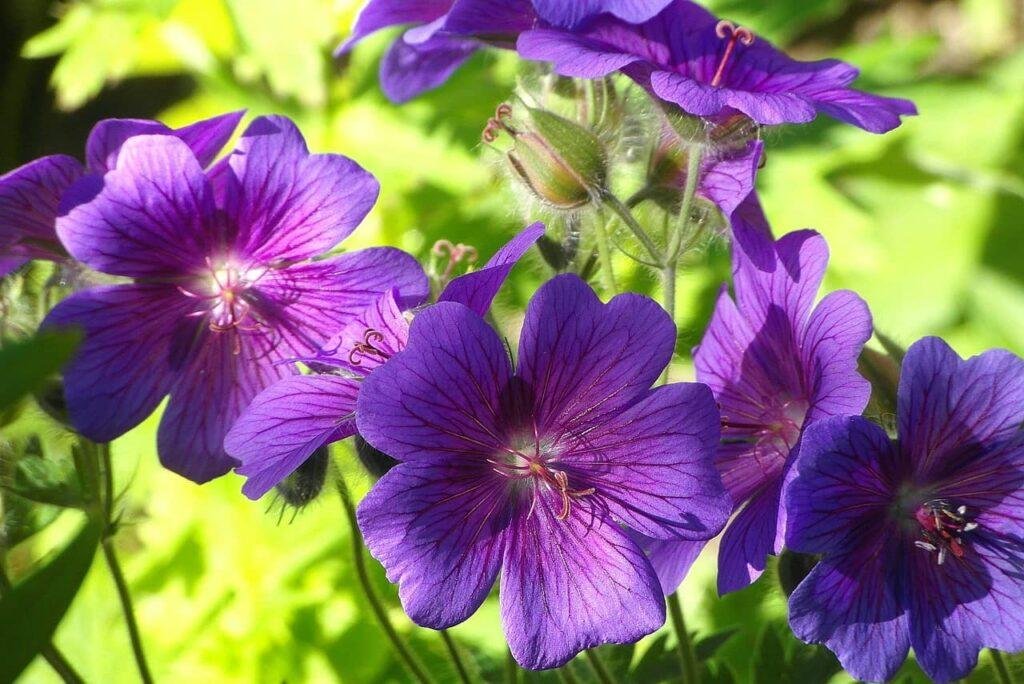
Geraniums are also commonly known as cranesbills. This plant is native to tropical mountains and temperate regions of Africa. The leaves of this plant are round in shape which are green in color, and its flower has five petals which are pink, blue, white, and purple in color. The English name ‘cranesbill’ is derived from the crane’s head.
Geranium Plant Overview
- Botanical Name: Geranium spp.
- Common Name: Perennial geranium, cranesbill geranium, hardy geranium, wild geranium
- Family: Geraniaceae
- Plant Type: Herbaceous perennial
- Bloom Time: Summer, fall, spring
- Soil Type: Medium moisture, well-drained
- Soil pH: Slightly acidic
- Sun Exposure: Partial to full sun
- Mature Size: 6–36 in. tall, 1–3 ft. wide
- Plant Flowers Color: Blue, lavender, pink, purple, white
- Hardiness Zones: 3–9 (USDA)
- Native Area: Africa
How to Grow & Care
Care requirements vary with different geranium varieties. It likes well-drained soil. This plant requires soil with an acidic pH and prefers moderately moist or well-drained soil. Water only when the topsoil is dry otherwise, overwatering leads to fungal diseases. It prefers temperatures between 65 and 75 degrees Fahrenheit during the day and about 50 degrees and 60 degrees at night.
[6] Phlox
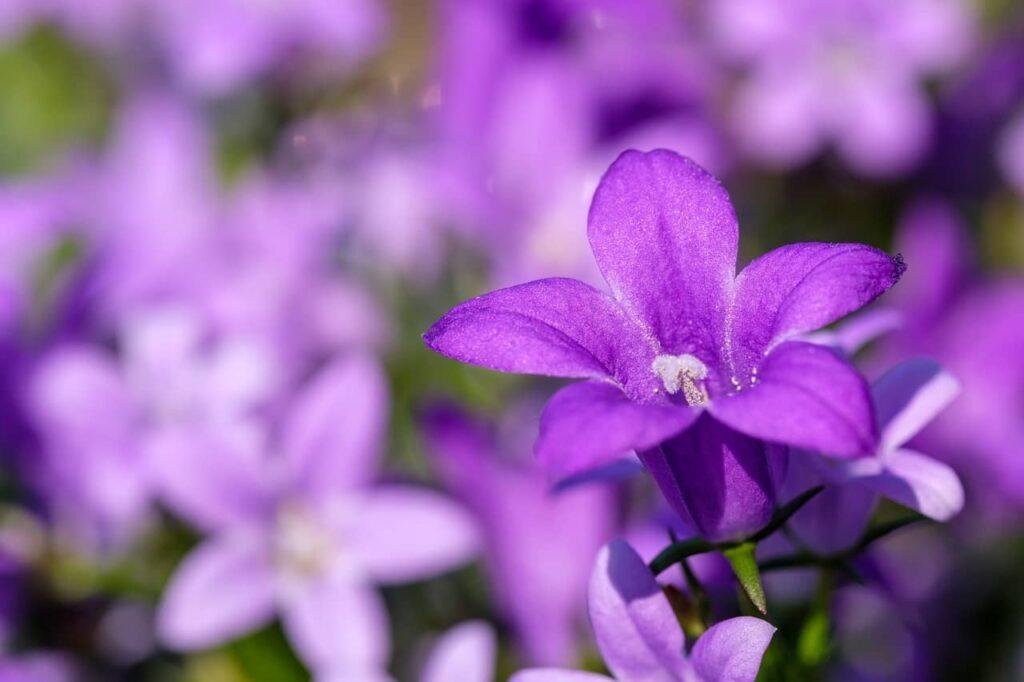
There are more than 65 species of the genus Phlox. The name of this plant is derived from the Greek word Phlox which means flame of intense color of flowers. The flowers of this plant are found in pink, bright red, purple, light blue, and white colors. Some varieties of this plant are fragrant. It is mostly located in North America. The flowers of this plant bloom in autumn, spring, and summer.
Phlox Plant Overview
- Botanical Name: Phlox
- Common Name: Phlox
- Family: Polemoniaceae
- Plant Type: Herbaceous perennial
- Bloom Time: Spring through late summer
- Soil Type: Loamy, rich, well-drained
- Soil pH: Neutral to acidic
- Sun Exposure: Partial to full sun
- Mature Size: Up to 5 ft. tall, depending on a variety
- Plant Flowers Color: White, pink, purple, blue
- Hardiness Zones: 3–9 (USDA)
- Native Area: North America
How to Grow & Care
Phlox needs more sunlight. This plant needs slightly acidic and well-drained soil. This plant is drought tolerant but requires regular watering during flowering. On hot summer days, the stems and flowers of this plant may dry out a bit. Phlox doesn’t need any fertilizer, but if you want to fertilize your soil, you should use compost.
[7] Lily Of The Nile (Agapanthus)
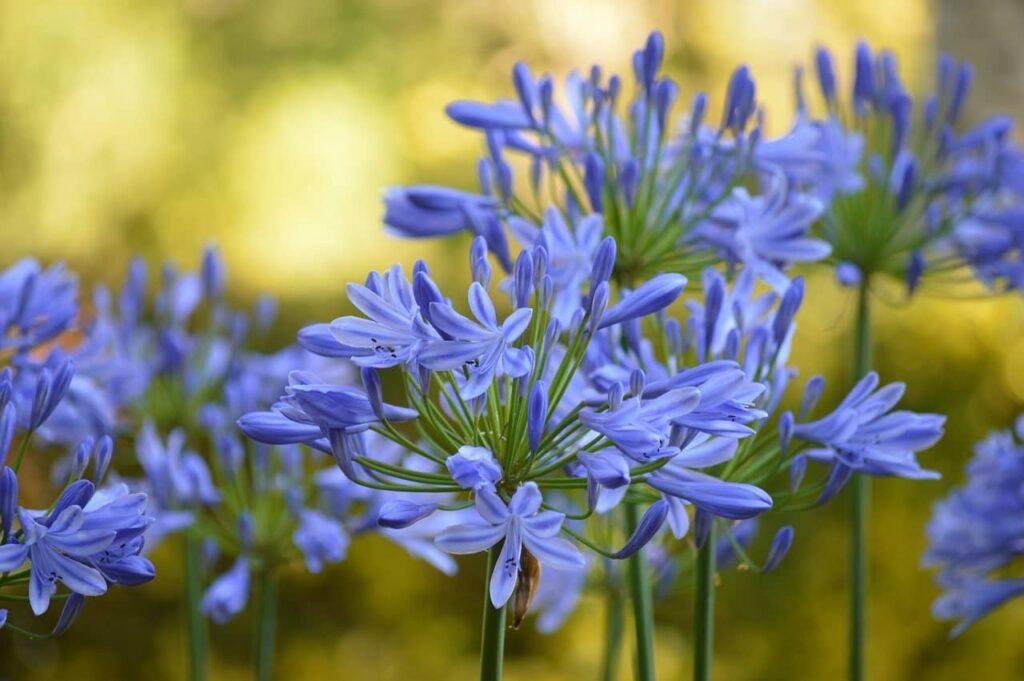
Agapanthus is known as the green of the Nile as most species of Agapanthus are native to the banks of the Nile, and all of these species are native to Lesotho, Mozambique, Eswatini, and South Africa. This plant has purple-colored flowers, which are round in shape. The purple, blue, white, and pink flowers of this plant bloom in early summer.
Agapanthus Plant Overview
- Botanical Name: Agapanthus
- Common Name: African lily, Lily-of-the-Nile
- Family: Agapanthaceae
- Plant Type: Herbaceous perennial
- Bloom Time: June, July, August, September
- Soil Type: Sandy loam, well-drained
- Soil pH: 5 to 7.5
- Sun Exposure: Partial to full sun
- Mature Size: 3 ft. tall, 2 ft. wide
- Plant Flowers Color: purple, blue, white, and pink
- Hardiness Zones: 7-10 (USDA)
- Native Area: South Africa
How to Grow & Care
Agapanthus is very easy to care for. This plant has USDA hardiness zones 7 to 10 and does not tolerate winter cold, so it needs winter protection. You can plant this plant during spring. Agapanthus requires about 6 to 8 hours of full light daily for best flowering and prefers acidic soil with a pH between 5.5 and 6.5. The temperature needed for this plant is 50 to 60 degrees Fahrenheit.
[8] Blue-Eyed Grass

Blue-eyed grass is a grass species native to North America. This plant is mostly found in hilly grassy areas of forests and along the banks of rivers. This grassy plant has blue and purple flowers that are very small. They are sown during spring. This plant likes to grow in clumps, and its leaves are long and thin.
Blue-Eyed Grass Overview
- Botanical Name: Sisyrinchium angustifolium
- Common Name: Blue-Eyed grass
- Family: Iridaceae
- Plant Type: Perennial
- Bloom Time: Late spring, early summer
- Soil Type: Moist, well-drained
- Soil pH: Acidic (5.0 to 7.0)
- Sun Exposure: Full, partial
- Mature Size: 8–20 in. tall, 6–12 in. wide
- Plant Flowers Color: Blue-violet
- Hardiness Zones: 4–9 (USDA)
- Native Area: Eastern North America (Northern Florida to Canada)
How to Grow & Care
Caring for this blue-eyed grass is quite easy. Give this plant plenty of light for foliage growth, and choose a partial light location for best flower growth. This plant prefers an acidic soil of 5.0 to 7.0. These plants are mostly found along the banks of rivers where the climate is humid. The ground of this plant should be well watered early in the morning, and the ground should not dry out. This plant does not need fertilizer, but if you want to get good flowers, you can supplement the ground with the necessary nutrients.
[9] Bellflower
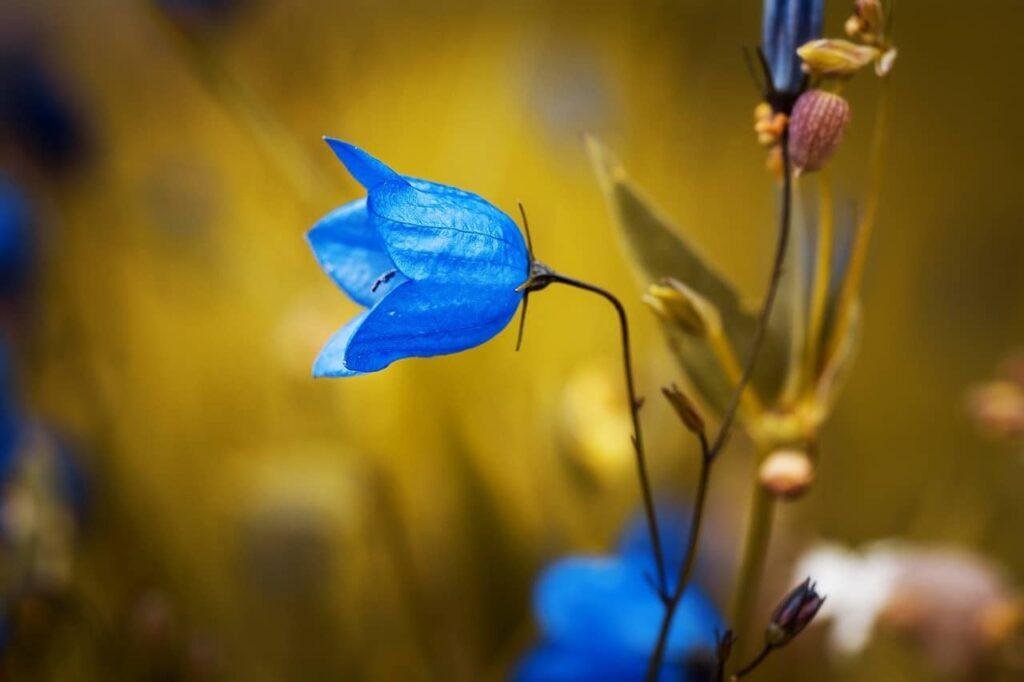
Bellflower, also commonly known as Campanula, belongs to the Campanulaceae family. As the flowers of this plant are shaped like a bell, it is named bellflower. This plant is mostly found in East Asia, the Balkans, and the Caucasus. The flowers of this plant are purple and blue in color. The plant has a long stem on top of which the flowers are borne in clusters.
Bellflower Overview
- Botanical Name: Campanula rapunculoides
- Common Name: Rampion bellflower, creeping bellflower
- Family: Campanulaceae
- Plant Type: Perennial, herbaceous
- Bloom Time: Summer
- Soil Type: Moist, well-drained
- Mature Size: 2–4 ft. tall, 1–3 ft. wide
- Plant Flowers Color: Blue, purple
- Hardiness Zones: 3–9 (USDA)
- Native Area: Europe, Asia
How to Grow & Care
Bellflowers need full sun, so plant them in a location that receives full light. This plant prefers moist soil. Night temperatures for this plant should stay above about 70℉. You can fertilize these plants for extra growth, but too much chemical fertilizer can kill them. Water the cutting once a week, and the soil should be moist under an inch.
[10] Dwarf iris

Dwarf iris is part of the flowering species, also known as “reticulated irises”. The plant bears blue and purple flowers with three petals. The plant has small and attractive flowers making it the first choice for a home and garden. The foliage of this plant is thin and grass-like and is considered poisonous to people and pets.
Dwarf iris Overview
- Botanical Name: Iris reticulata
- Common Name: Netted Iris, Reticulated Iris, Dwarf Iris
- Family: Iridaceae
- Plant Type: Perennial, bulb
- Bloom Time: Spring
- Soil Type: Loamy, Sandy, Well-drained
- Soil pH: Neutral, Alkaline
- Sun Exposure: Full, partial
- Mature Size: 8–20 in. tall, 6–12 in. wide
- Plant Flowers Color: Purple, Blue
- Hardiness Zones: 5–9 (USDA)
- Native Area: Europe, Asia, Middle East
How to Grow & Care
Caring for irises is very easy. This plant should be planted in the fall, producing about 4 inches deep and 3 inches apart. This plant likes a moist environment and should be watered when the top surface of the soil is dry. Dwarf iris can be grown in USDA hardiness zones 5 through 9. A slightly alkaline soil is best for this plant.


Hello to all, it’s truly a pleasant for me to pay a
quick visit this web page, it contains important Information.
I like what you guys tend to be up too. This sort
of clever work and coverage! Keep up the amazing works guys I’ve included you guys to blogroll.
Greate pieces. Keep writing such kind of info on your site.Im really impressed by your site.Hi there, You have done a great job. I’ll certainly diggit and in my view recommend to my friends. I am confident they’ll be benefited from this web site.
We absolutely love your blog and find nearly all of your
post’s to be precisely what I’m looking for.
can you offer guest writers to write content for you personally?
I wouldn’t mind creating a post or elaborating on a number
of the subjects you write related to here. Again, awesome blog!
Wonderful, what a webpage it is! This weblog provides valuable data to us, keep it up.